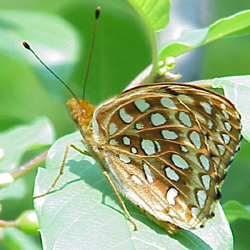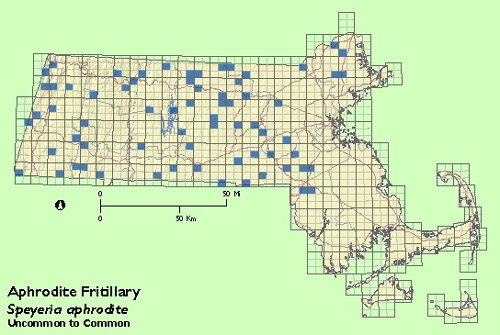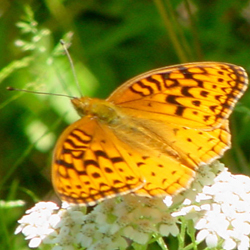Butterfly Atlas
Find a Butterfly
Aphrodite Fritillary
Speyeria aphrodite
Named
Fabricius, 1787

Identification
Wingspan: 2 - 2 7/8". Distinguished from Great Spangled Fritillary by the black spot near the base of the forewing above; the relatively narrow yellow band between the two rows of silver spots on the hindwing below; and the dark dots at the tips of the inner band of silver spots on the hind wing below. Told from Atlantis Fritillary by relatively large size; lighter coloration; and black marginal lines that are clearly double (fused in Atlantis). For a comprehensive comparison of these three look-alikes, see Identification under Great Spangled Fritillary.
Distribution
North America. Nearly transcontinental and overlapping the range of Great Spangled but stopping at the Cascades and the Great Basin and thus not reaching the Pacific or the Sierra Nevada. In the eastern half of the continent, reaches its southern limit in central Iowa, northern Illinois and Indiana and northern Georgia and Alabama in the Appalachians. Occurs throughout New England; generally becomes commoner as Great Spangled becomes rarer northward and in the highlands, but drops out at the highest elevations and the most northerly areas and is replaced by Atlantis. Likewise, replaced by cybele southward and at lower elevations.
Status in Massachusetts
Uncommon to common during the atlas period (1986-90) throughout most of the state, but absent or nearly so from Cape Ann, the southeastern coastal plain, Cape Cod and the Islands. Maximum: c.50, Millis (Norfolk Co.), 9 July 1979. Apparently much commoner historically (see Notes, below), and many experienced observers perceive a significant decline in this species in recent decades.

Flight Period in Massachusetts
Closely parallels that of Great Spangled Fritillary, mainly from the last week in June to the first week in September. Scudder (1889) and others assert that it emerges and also disappears on average about a week later than cybele, but Atlas data do not corroborate this. Extreme dates: 22 June 1988, Greenfield (Franklin Co.), M. Fairbrother; 12 September 1991, Rockport (Essex County), a very worn individual, B. Cassie; 11 September 1994, Milford (Worcester Co.) R. Hildreth.
Larval Food Plants
Violets. See discussion under the previous species which also applies here. Massachusetts violets reported as hosts for Aphrodite are: Common Blue Violet (Viola papilionacea), common in wet meadows and moist woods; Lance-leaved Violet (V. lanceolata), common in wet meadows and shores; Ovate-leaved Violet (V. fibriatula), common in dry, open areas; Primrose-leaved Violet (V. primulifolia), wet meadows and moist open woods; and Kidney-leaved Violet (V. nephrophylla), cold mossy bogs and shores.
Adult Food sources
Strongly attracted to a wide variety of mid- and late summer wildflowers including milkweeds, composites and members of the pea family; 16 species recorded by Atlas volunteers.

Habitat
Open habitats, including wet meadows, upland fields and power line corridors; also bogs and woodland edges. There are conflicting speculations in the literature and among Atlas and other field workers on the preferred habitat of this species, some asserting, for example, that Aphrodite prefers higher, drier and more acidic sites than Great Spangled and appears less frequently in gardens, while others insist that it prefers wetland areas. Because it is known to feed on both upland and wetland species of violets, it may be that its local abundance depends on the which violet species a population of the butterfly happens to colonize.
Life Cycle
EGG: Creamy white to violet, tan and reddish brown as they mature; dome shaped open at the top with slender but distinct vertical ribbing, fine horizontal ribbing and intermittent circular pits. OVIPOSITION: Eggs laid singly on or near food plant. LARVA: Dark brownish black with scattered ocher markings; covered with dense bristly spines. CHRYSALIS: Rusty brown to blackish with rows of spines along the length of the abdomen; generally resembles a shriveled dead leaf. PUPATION: Suspends chrysalis from vegetation. OVERWINTERING STAGE: First instar larva.
In larval and adult behavior, Aphrodite is essentially similar to Great Spangled Fritillary.
Notes
The account by Colonel T.W. Higginson (quoted by Scudder, 1889) of a mid-July walk near his home in Princeton, Mass. provides an evocative, if unscientific, comparison between the abundance of butterflies in the last century and that of today: "I might have picked off hundreds of aphrodites by hand...and all the interspaces between their broader wings seemed filled with little skippers and pretty painted ladies and an occasional comma", and, the next day, " between the two Wachusetts...the aphrodites and tharos (Pearl Crescents) were so thick in the road, I brushed them away."
Account Author
Chris Leahy



